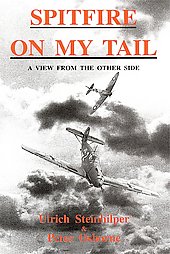Introduction:
Eckardt’s ‘Jet Web’ offers a comprehensive exploration of the development history of turbojet engines from the 1920s to the late 1950s. It primarily focuses on the intricate relationships and collaborations between the United Kingdom (& USA), Germany, and Switzerland in this fascinating journey. While the narrative repeats in parts the well-known ‘Whittle vs. Von Ohain Saga’, it mainly sheds new light on unexpected connections and especially, the significant influence of axial compressor technology from the Swiss-German company Brown Boveri & Cie.
The author, a gas turbine engineer, spent a decade meticulously researching and compiling this remarkable account, resulting in a weighty volume with some 250 informative b/w photographs, technical schemes and detailed drawings. This document provides an overview of the book’s content, emphasizing its unique contributions and the target audience it aims to engage.
Historical Context:
The book sets the stage by providing a concise overview of technological developments over the centuries, leading to the emergence of air-breathing jet engine technology at the early 20th century. The introductory section provides essential context and informative historical perspective.
Pre-World War II Developments and Collaborations:
In addition to the well-known Von Ohain story at Heinkel on radial turbomachinery, for the first time the book digs out the early beginnings of axial turbomachinery design at Prandtl’s Aerodynamische VersuchsAnstalt (AVA) Goettingen since the mid-1920s for high-altitude flight applications. One of the book’s central themes revolves around the collaborations that occurred among Great Britain, Switzerland and in parts also Germany in the years leading up to World War II. Notably, in 1935, Rolls- Royce and the Swiss Brown Boveri (BBC) secretly collaborated on turbocharger development, yielding innovative advancements, such as turbine blade film cooling and axial compressors, integrated in industrial and flight-worthy gas turbine hardware.
The Role of Brown Boveri:
Brown Boveri’s contributions, often overlooked, played a crucial role in the development of turbojet engines in both England and Germany. The Swiss company’s contribution, led by Claude Seippel, played a pivotal role in advancing the field of advanced axial compressors and industrial gas turbines. Notably, the pre-war collaboration of BBC Switzerland with the Royal Aircraft Establishment (RAE) in Britain regarding axial compressors, and the remarkable best performance axial compressor upgrade of the BMW 003 C/D versions by BBC Mannheim after 1941 are highlighted.
Anecdotal Gems:
The book offers intriguing anecdotes, such as the scientific dispute between AA Griffith and Professor Ludwig Prandtl, which caused Griffith’s – for England’s further turbojet engine developments important – shift from fracture mechanics to turbomachinery design in 1926. The German-British contacts formed during mountain glider camps at Wasserkuppe, from where B Shenstone brought the elliptical wing to the Spitfire aerodynamics, are also brought to light. Additional anecdotes, in-depth technical information, and background information about individuals involved can be discovered within the extensive collection of footnotes, which should not be disregarded or overlooked.
Four Excursions:
Throughout the chronologic narrative, the author presents four detailed ‘excursions’ that delve into the lives and contributions of leading engineers. These include Claude Seippel, the ‘Father of the Axial Compressor’; Fritz Heppner, a Jewish-German engineer who emigrated to England in 1935 and played a significant role at Armstrong Siddeley Motors; Helmut Schelp, a talented, US-trained engineering rookie, who directed the German turbojet engine program during WWII out of a small department within Goering’s Air Ministry; and Hermann Reuter, whose developments at BBC Mannheim led to the superior efficiency in BMW turbojet engines up to 1945, the technology of which was finally, successfully introduced by Hermann Oestrich and his team at Snecma’s ATAR engines after the war.
Parallel Development of Jet Engines:
The book provides fresh insights into the parallel development of jet engines by Sir Frank Whittle in the UK and Hans von Ohain in Germany. Whittle patented the jet engine in 1930 but faced funding challenges, resulting in a delayed first flight in May 1941. In contrast, Von Ohain secured a secret patent in 1938 and achieved the first flight in August 1939; Eckardt discusses these patents in detail in a special attachment. However, as said before, the book puts for the first time special emphasis and detail on axial engine developments up to series production, like the Junkers Jumo 004 and the BMW 003 in powering iconic aircrafts like Messerschmidt Me262 fighter and Arado Ar234 bomber.
Global Knowledge Transfer:
A significant portion of the narrative explores the transfer of knowledge and technology. It covers the migration of ideas, of licensed BBC information and of Whittle’s engine designs to the United States (General Electric, Allis-Chalmers, Westinghouse, and Pratt & Whitney) before and during the war, and the post-war transfer of German engine design experience to France (Snecma) and Russia (Lyulka and Kuznetsov), and of transonic wind tunnel hardware and operational know-how to England..
Conclusion:
‘Jet Web’ is a groundbreaking work that unveils in a comprehensive approach the so-far hidden connections in the development history of turbojet engines. Eckardt’s meticulous research and authoritative account go beyond the achievements of Whittle and Von Ohain, providing a grand engineering view of the development of jet engines and, where necessary, gas turbines in general. This monumental book, with its extensive bibliography and detailed index, is a must-read for engineers, technology historians, and enthusiasts interested in the fascinating world of aviation and engine technology.
Dr. Dietrich Eckardt looks back on forty years of professional experience in turbomachinery research, the German turbojet engine industry, and Swiss heavy-duty gas turbine industry. In 2017, his exceptional accomplishments were recognized with the prestigious ASME Engineer-Historian Award, presented by the American Society of Mechanical Engineers, in honor of his noteworthy technical-historical publication, ‘Gas Turbine Powerhouse’.
Review written by Dr. Alexander Beeck, retired, former Director Gas Turbine Engineering and Senior Technical Expert in Siemens Power Generation Inc., Orlando, FL, USA.











Have just bought this book and have dipped into
several times. A very thorough but discursive effort that will take a year to read and properly understand.
Echardt is not afraid to criticise commonly held views. I wonder what the Rolls Royce Heritage Society will make of what Echardt thinks of their hero-AA Griffith